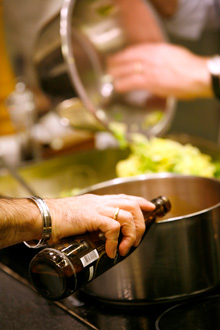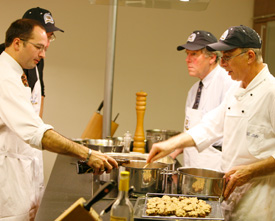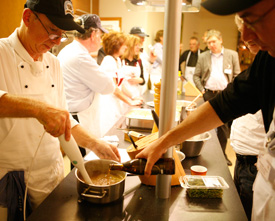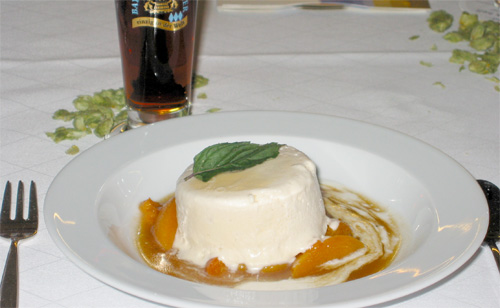
Over the past few decades, beer has reclaimed its rightful place as both ingredient and accompaniment in private and professional kitchens. Beer for deglazing a pan, steaming mussels, mopping a roast, or providing substance to a beef stew has long ceased to be a novelty. But Michelin star chef Werner Licht of Haralds Kochschule in Munich, Germany, has taken the concept of beer cuisine one tricky and daring step further…into the forbidden realm of reductions!
Classic reductions are usually clear sauces, such as velouté or sauce espagnole, “reduced,” after patient boiling, from white or brown stock, bouillon, or consommé—usually with a hefty portion of wine, and always flavored with herbs and spices. They are then strained, and served hot or cold, and sometimes jellied. Their concentrated flavor and velvety smoothness can transform even an ordinary dish, such as a humble hamburger, a simple steak or pork chop, or a delicate white fish, into a sublime one.
Chef Licht agreed to share some of his magical beer reduction methods with Zymurgy readers. Following are recipes for an eggplant and chèvre (goat cheese) terrine, a monkfish filet, a veal roast, and an ice parfait with apricots—all of which show off the “haute” flavor potential for reductions made not with wine, but with beer.
The technique for making reductions grew out of the French saucier tradition. The classic reference model for all reductions is without a doubt Georges Auguste Escoffier’s demi-glace (“half-glaze”), which was first published in his 1903 cookbook Le Guide Culinaire. This sauce is a rich, deep, meaty glaze, the essence of brown stock (fond brun or estouffade in French) that has been concentrated from water, marrow bones, a mirepoix (a finely diced mixture of carrots, onions, and celery), a bouquet garni, and some optional red wine. It is reduced three times. During the first reduction, the volume shrinks by 90 percent or more. At the end, the solids are strained and discarded. For the second reduction, a brown roux (a slow-cooked mixture of flour and butter) is added, as well as more mirepoix and some tomato puree or paste. At this stage, the brown stock becomes a sauce espagnole. During the final reduction, the sauce espagnole is mixed with fresh brown stock, flavored with a new bouquet garni, and often finished with a good dose of sherry. This basic demi-glace technique by Escoffier is also at the heart of a good beer reduction.
The Two Sides of Bitter
In classic reductions, however, all liquids and ingredients differ from beer in one key variable: Beer contains alpha-acids, that is, non-volatile hop resins. In the beer we drink, of course, these provide a pleasant balance to beer’s malty sweetness; but when we condense beer in a beer reduction, the bittering that is so pleasing in an IPA is likely to become overbearing in the concentrated sauce. This is particularly noticeable in beers that are flavored with strongly piney, pungent, or citrusy hop varieties such as Ahtanum, Amarillo, Cascade, Chinook, Columbus, Simcoe, or Tomahawk. To ensure that the reduction does not become too acrid and assertive on the palate, or even inedible, the selection of beer is paramount.
 While heavily hopped beers—such as IPAs or anything labeled “imperial” or “double”—can be used in sauces in small quantities, more like a spice, or as a deglazing medium in a pan to dissolve savory meat juices, they are not suitable for reductions. Instead, select only mildly hopped brews, and make sure they are also malt-accented. Beers flavored with UK Golding-like or German Mittelfrüh-like hops are best suited for reductions.
While heavily hopped beers—such as IPAs or anything labeled “imperial” or “double”—can be used in sauces in small quantities, more like a spice, or as a deglazing medium in a pan to dissolve savory meat juices, they are not suitable for reductions. Instead, select only mildly hopped brews, and make sure they are also malt-accented. Beers flavored with UK Golding-like or German Mittelfrüh-like hops are best suited for reductions.
Most industrial mass-market beers, however, in spite of being fairly low in hop bitterness, are usually not suitable. This is because they are frequently made with rice and/or corn adjuncts and thus lack the required counterbalancing maltiness. Reductions made with such beers simply have no body and taste too empty. The best beers for reductions, therefore, are such classic Bavarian styles as Helles, Märzen-Oktoberfest, Dunkel, Hefeweizen, Kellerbier, Bock, Doppelbock, and Eisbock. These are generally low in alpha-acids, while being rich in maltiness. You’ll be surprised how much the hoppiness-maltiness balance shifts in favor of hoppiness during a reduction!
A Basic Beer Reduction Recipe
The first step for a beer reduction is to make a flavorful starter stock. Given the endless variations of ingredients from which one can make stock—beef, veal, poultry, lamb, game, fish, and just about any type of vegetable—the following is a simple, basic guideline that can be adapted in many different directions:
To obtain about 3 cups of starter liquid for a reduction, combine:
- 5 cups of water
- 1 celery stalk with leaves, washed, cut into pieces
- 1 bay leaf
- ½ teaspoon black or white pepper
- 8 ounces of cubed fish or meat (and/or marrow bones, sawed into pieces)
- 1 sliced or diced onion
- ½ teaspoon salt
In a large saucepan, bring the mix to a rolling boil. Then reduce the heat, cover, cook for approximately 30 minutes, strain, and discard the solids. Add one or two cups of beer and reduce the stock further, down to the consistency of thick syrup. Turn off the heat. To smooth out the reduction, fold about 2 tablespoons of cold butter into it. Finally, for additional flavor, you can fold in an optional 1 fluid ounce of beer as well.
Four Dishes with Beer Reductions
 The following is a three-course menu with ingredients measured for four persons. The appetizer is an eggplant and chèvre terrine. There is a choice of monkfish or veal roast as the main course. An ice parfait with apricots is the dessert. Each dish features a different version of a beer reduction. These recipes were developed at Haralds Kochschule, a Munich cooking school owned by Chef Harald Schultes, where I have attended two one-day beer cooking courses organized by the Bavarian Brewers Federation. The courses were taught by the federation’s general manager Walter König and Chef Licht. The recipes presented here formed the menu in one of these courses. I adapted them slightly for North American kitchens; and they are used by permission of Haralds Kochschule.
The following is a three-course menu with ingredients measured for four persons. The appetizer is an eggplant and chèvre terrine. There is a choice of monkfish or veal roast as the main course. An ice parfait with apricots is the dessert. Each dish features a different version of a beer reduction. These recipes were developed at Haralds Kochschule, a Munich cooking school owned by Chef Harald Schultes, where I have attended two one-day beer cooking courses organized by the Bavarian Brewers Federation. The courses were taught by the federation’s general manager Walter König and Chef Licht. The recipes presented here formed the menu in one of these courses. I adapted them slightly for North American kitchens; and they are used by permission of Haralds Kochschule.
The Munich beer cooking courses are eight-hour kitchen marathons. Each course is limited to 16 culinary professionals, split into groups of four. Each group is responsible for cooking one menu item for the entire class. König and Licht give short presentations about the flavor highlights to be achieved in the different dishes; the way the beer and the food are to complement each other; and the cooking techniques to be employed. The prep work and the actual cooking are scheduled throughout the day so that the entire class has enough time to sit down to eat each dish as soon as it is cooked and to critique the result.
RECIPES
Appetizer: Eggplant and Chèvre Terrine in Herbed Beer Dressing
In this appetizer, the beer partners with diced tomatoes in a reduction that serves as the base for a cold, gelatinous terrine, as well as an ingredient in the terrine dressing. Because of the creaminess of the goat cheese, you can accompany this appetizer with a hop-accented, palate-cleansing beer such as a hoppy Pilsner, a pale ale, or an IPA. Ingredients
- 1 small eggplant
- 1 small can diced tomatoes (14.5 ounces)
- 1 envelope unflavored gelatin
- 1 teaspoon dried thyme
- 1 teaspoon dried basil
- 1 shallot
- 1 clove garlic (optional)
- 1 log fresh goat cheese (4 ounces)
- Olive oil as needed
- Salt, pepper to taste
- ½ cup sifted flour (enough for coating eggplant slices)
- ½ cup mayonnaise
- 1 teaspoon spicy mustard (Dijon- or Düsseldorf-style)
- 1 bunch Italian parsley
- 4 to 5 basil leaves (fresh and finely chopped) or about 1 tablespoon dried basil
- 1 fresh tomato
- 1 tablespoon vinegar
- 4 fl. oz. blond lager (such as Helles or Pilsner)
- Arugula or leafy lettuce for garnishing
Instructions
- Peel and slice shallot. Sauté in pot in olive oil. Add thyme, can of tomatoes, 2 fl. oz. beer, as well as the whole clove of garlic if used. Simmer to reduce until mixture has the consistency of a sauce. Season with pepper and salt to taste. If too thick, add a bit more beer. Remove the garlic if used. Puree and pass through a fine sieve.
- Hydrate gelatin in ½ cup cold water (follow instructions on package; takes about 1 to 5 minutes). Add to hot tomato sauce. Place sauce in cold-water bath to chill while stirring constantly.
- Wash and cut eggplant into about ½-inch thick slices. Season these with pepper and salt, and coat them lightly with flour on both sides. In a large pan, fry them in oil and dry them on paper towels.
- Line a rectangular cake mold with clear plastic wrap. Coat wrap with some of the cold tomato sauce. Add eggplant slices and tomato sauce in layers until about ½ inch below the mold’s rim. Refrigerate.
- Place goat cheese in bowl, add about 1 tablespoon of olive oil, and beat the two ingredients into a creamy mass. Season with salt and pepper. Spread the cheese over the terrine. Cover with plastic wrap and place back in refrigerator to let set firmly.
- Wash Italian parsley and separate from stems. Blanche parsley in hot salted water for a minute. Then “shock” it in ice water and dry it in sieve. In a small blender, purée it with 1 fl. oz. of beer.
- Blanch and peel fresh tomato. Remove seeds. Dice tomato finely.
- In a bowl, mix mustard, vinegar, mayonnaise, diced tomato, basil, and parsley mixture for a green dressing.
- For plating, wash arugula or leafy lettuce and place on plates.
- Remove terrine from refrigerator and place upside down on cutting board. Lift mold and carefully remove plastic wrap. Slice terrine using a hot, sharp knife.
- Place terrine slices on plated leaves and cover with green dressing to taste.
Main Course 1: Monkfish on Wilted Spinach with Mushrooms and Balsamic Vinegar Beer Sauce
 The centerpiece of this dish are two medallions of monkfish per person served on a bed of wilted spinach, surrounded by chanterelles (or other delicate, diced mushrooms) smothered in a white reduction made from beer-and-fish stock and laced with a second, dark, velvety reduction of balsamic vinegar and beer. If monkfish is difficult to come by, filets of cod, haddock, or other non-oily ocean fish are suitable substitutes. To plate the dish, place a handful of spinach in the center and douse it with spoonfuls of the dark sauce. Then place two pieces of fish on top of the spinach and cover these with the white sauce. Finally, sprinkle the chanterelles over the entire dish. A chewy Hefeweizen supports, rather than interferes with, the food flavors and thus provides a relatively neutral background for the mild fish and its heftier accompaniments.
The centerpiece of this dish are two medallions of monkfish per person served on a bed of wilted spinach, surrounded by chanterelles (or other delicate, diced mushrooms) smothered in a white reduction made from beer-and-fish stock and laced with a second, dark, velvety reduction of balsamic vinegar and beer. If monkfish is difficult to come by, filets of cod, haddock, or other non-oily ocean fish are suitable substitutes. To plate the dish, place a handful of spinach in the center and douse it with spoonfuls of the dark sauce. Then place two pieces of fish on top of the spinach and cover these with the white sauce. Finally, sprinkle the chanterelles over the entire dish. A chewy Hefeweizen supports, rather than interferes with, the food flavors and thus provides a relatively neutral background for the mild fish and its heftier accompaniments.
Ingredients (Monkfish)
- 8 pieces monkfish (about 50 g or 1.75 oz each—use two pieces per person)
- 14 ounces (approx.) fresh spinach
- ½ teaspoon nutmeg
- Pepper, salt to taste
- 7 ounces (approx.) fresh firm mushrooms. Chanterelles are best, but cremini, porcini, or button mushrooms work, too. Black trumpet mushrooms or morels would be scrumptious!
Ingredients (White Sauce)
- 1 shallot
- 4.25 fl. oz whipping cream
- 4 tablespoons Pilsner or similar blond lager (for the sauce)
- 10.5 ounces butter
- 1 cup fish stock (for instructions, see below)
- 1 cup Pilsner or similar blond lager (for fish stock)
Ingredients (Dark Sauce)
- 3 shallots
- 8 peppercorns (preferably white, but black OK, too)
- 2 bay leaves
- 1 sprig fresh thyme
- 1 sprig fresh rosemary
- 8.5 fl. oz. dark balsamic vinegar
- 8.5 fl. oz. veal or chicken broth
- 5.3 oz. butter, refrigerated
- 4.25 fl. oz. Pilsner or similar blond lager
Instructions
- To make the fish stock, dice about 3 ounces of white fish and one celery stalk and boil in about one cup each of beer and water for about 30 minutes. Strain and discard solids.
- Peel and slice one shallot and braise in a little bit of butter in a pot. Add fish stock and reduce to almost nothing. Stir in whipping cream and bring to a boil. Turn off heat. Fold in butter until the mixture is thick and smooth. Fold Pilsner into the white sauce. Set aside and keep warm.
- Wash spinach, let drip-dry. Season with pepper, salt, and nutmeg. Over high heat, cook in butter until wilted, using kitchen tongs to turn constantly. Set aside and keep warm.
- Clean mushrooms and dice into ½ x ½ inch pieces. Brown quickly in butter. Set aside and keep warm.
- Peel and slice three shallots and braise in a little bit of butter. Add herbs, balsamic vinegar, and veal or chicken stock. Reduce to a thick syrup. Add Pilsner and pass through a sieve. Stir cold butter into sauce. Season to taste with salt and pepper. Set aside and keep warm.
- Season monkfish with pepper and salt and fry quickly in very hot pan in oil (such as peanut or rape seed oil).
- Plate as described above.
Main Dish 2: Veal Roast in Beer Mustard Sauce with Oregano, Fava Beans, and Potatoes au Gratin
This course is both the menu’s tour de force and its pièce de résistance. Depending on the diners’ appetites, it can be served after or instead of the monkfish. To plate it, place the beans and the potatoes au gratin next to each other and a slice of veal roast on top of the beans. Cover the meat with the sauce. Serve this hearty dish with a malt-accented brew that brings out the dominant meat flavors. Ideal is a Bavarian Dunkel or similar dark lager. Possible ale alternatives are an English-style dark ale, an Irish red ale, or a Düsseldorf-style, copper-colored Alt.Ingredients (Roast)
- 1 veal roast, boneless (approx. 28 oz.)
- 2 onions
- 2 carrots
- 1 celery stick
- 3 cloves garlic
- 2 bay leaves
- 5.3 ounces bacon
- 1.75 ounces dried morels (or other dried mushrooms)
- 1 sprig fresh oregano
- 1 sprig fresh thyme
- 3.5 ounces butter
- 8.5 fl. oz. Dunkel or similar dark beer
- 25 fl. oz. (approx.) veal or beef stock
- 3 tablespoons flour
- 6.75 fl. oz. medium cream
- 3 tablespoons mustard
Ingredients (Potatoes)
- 4 potatoes
- 1 onion
- 1 clove garlic
- Pinch of nutmeg
- 4 tablespoons grated Parmesan cheese
- Some butter (cold)
- Baking dish lined with parchment paper
Ingredients (Beans)
- 7 ounces fresh fava beans
- 1 onion
- 1 sprig fresh savory
- 1 bunch scallions
- 3.5 ounces butter
Instructions (Roast)
- Soak dried mushrooms in lukewarm water for about 30 minutes. When soft, wash and chop finely.
- Peel onions and carrots. Dice celery, onions, carrots, and bacon.
- De-stem thyme, oregano, and rosemary and chop finely (or use dried).
- Season meat with salt and pepper. Roll in chopped herbs.
- Render bacon bits in oil in roasting dish. Remove bacon and save.
- Place meat in roasting dish and sear on all sides. Then place meat on a rack in the roaster and add the vegetables and mushrooms. Bake in preheated oven for about 10 minutes at 325° F.
- Remove the rack and roast. Drain roasting liquid into a small pot, dust liquid with a bit of flour, and stir flour in. Cook liquid, while stirring and adding half the beer.
- Return half the meat broth into the roaster. Add bay leaves and garlic. Immerse meat in liquid and cook for about 45 minutes on medium heat, until done. Turn the meat over several times during cooking. As liquid gets reduced during cooking, augment it several times with more beer and stock.
- When done, remove the meat, wrap in aluminum foil, and keep warm.
- Combine the remaining beer and broth, if any, with the roasting liquid and reduce vigorously while stirring constantly. Once thickened, stir in the cream and bring to a quick boil. Then shut off heat and add the mustard, oregano, and bacon bits.
- Slice the warm roast before serving.
Instructions (Potatoes)
- Peel and slice onion and garlic; brown gently in oil in pan. Remove garlic.
- Peel and cut potatoes into thin slices. Mix with onions and season with pepper, salt, and nutmeg.
- Place in baking dish lined with parchment paper.
- Sprinkle parmesan cheese on top, and garnish with flakes of butter.
- Bake in preheated oven at approx. 350° F for about 45 minutes (logistically do this after you have baked the meat).
Instructions (Beans)
- Wash and clean beans, blanch in boiling salt water. Shock in cold water. Slice into 1-inch pieces.
- Wash and slice scallions. Sweat in butter (soften without browning) in a pan. Add beans. Season with salt and pepper. Add a bit of water and cook covered until beans are al dente.
- Wash and de-stem savory. Chop finely and add to beans. Thicken liquid with a bit of water and cornstarch.
Dessert: Dark Beer Ice Parfait with Apricots

Logistically, the ice parfait needs to be made several hours ahead of time and kept in the freezer to set. For plating, the parfait is unmolded and served on top of a mound of apricots in the center of the plate, with a dribbling of sour cream sauce and a mint leaf as garnish. This dessert is best washed down with a strong and very malty brew, such as a Maibock, a Doppelbock, or an Abbey Ale.
Ingredients (Sauce)
- 1 small container sour cream
- 1 lemon
- 1 tablespoon powdered sugar
- 3 tablespoons milk
- 1 bunch of mint as garnish
Ingredients (Parfait)
- 3 egg yolks
- 1 whole egg
- 3.5 oz. sugar
- 5 fl. oz. Dunkel or similar dark lager
- 14 oz. whipping cream
Ingredients (Apricots)
- 8.8 ounces fresh apricots
- 5 tablespoons brown sugar
- 3.5 ounces butter
- 4 fl. oz. (approx.) Dunkel or similar dark lager
- 1 vanilla bean
- 2 lemons
Instructions
- Whip cream until stiff.
- In a metal bowl, mix egg yolks, egg, sugar, and beer. Place over hot water (“bain Marie”) and whisk until creamy.
- Then place in bowl of ice water while continuing to stir.
- Fold whipped cream into cold mixture.
- Fill into small ramekins or similar forms and place in freezer.
- Wash apricots, remove pits, and cut into small strips.
- Melt butter in frying pan. Add sugar and allow it to caramelize.
- Add apricots and fry very briefly, while adding the Dunkel in small increments to keep the apricots moist.
- Open vanilla bean, scrape out the seeds, and add these to the apricots. Also add some sugar and lemon juice to taste. Set aside.
- Finally make the sauce by whipping the sour cream, powdered sugar, and a little milk in a metal bowl until foamy.
- Serve by placing the apricots in the center of the plate, topping them with the parfait, dribbling some sauce over the top, and garnishing the lot with a mint leaf.
Horst Dornbusch is a Massachusetts-based consultant in the international brew industry, the author of several books on beer, the associate editor of the upcoming Oxford Companion to Beer, and a frequent contributor to Zymurgy.


Share Post